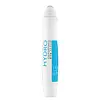What's inside
What's inside
 Key Ingredients
Key Ingredients

 Benefits
Benefits

 Concerns
Concerns

No concerns
 Ingredients Side-by-side
Ingredients Side-by-side

Water
Skin ConditioningButylene Glycol
HumectantDimethicone
EmollientPropanediol
SolventIsononyl Isononanoate
EmollientPhenyl Trimethicone
Skin ConditioningGlycerin
HumectantPhenoxyethanol
PreservativePEG-20 Methyl Glucose Sesquistearate
EmulsifyingPolymethylsilsesquioxane
Caprylic/Capric Triglyceride
MaskingAnthemis Nobilis Flower Water
MaskingAcrylates/C10-30 Alkyl Acrylate Crosspolymer
Emulsion StabilisingEthylhexylglycerin
Skin ConditioningCaprylyl Glycol
EmollientDimethicone/Vinyl Dimethicone Crosspolymer
Skin ConditioningSodium Polyacrylate
AbsorbentSodium Hydroxide
BufferingCaffeine
Skin ConditioningCamellia Japonica Seed Oil
EmollientCreatine
Skin ConditioningDisodium EDTA
Sodium Hyaluronate
HumectantPropylene Glycol
HumectantThymus Vulgaris Extract
PerfumingCapsicum Annuum Leaf Extract
Skin ConditioningRubus Idaeus Leaf Extract
Skin ConditioningSodium Carrageenan
Emulsion StabilisingMaris Sal
Skin ConditioningCI 42090
Cosmetic ColorantWater, Butylene Glycol, Dimethicone, Propanediol, Isononyl Isononanoate, Phenyl Trimethicone, Glycerin, Phenoxyethanol, PEG-20 Methyl Glucose Sesquistearate, Polymethylsilsesquioxane, Caprylic/Capric Triglyceride, Anthemis Nobilis Flower Water, Acrylates/C10-30 Alkyl Acrylate Crosspolymer, Ethylhexylglycerin, Caprylyl Glycol, Dimethicone/Vinyl Dimethicone Crosspolymer, Sodium Polyacrylate, Sodium Hydroxide, Caffeine, Camellia Japonica Seed Oil, Creatine, Disodium EDTA, Sodium Hyaluronate, Propylene Glycol, Thymus Vulgaris Extract, Capsicum Annuum Leaf Extract, Rubus Idaeus Leaf Extract, Sodium Carrageenan, Maris Sal, CI 42090
 Reviews
Reviews

Ingredients Explained
These ingredients are found in both products.
Ingredients higher up in an ingredient list are typically present in a larger amount.
Caffeine is most associated with coffee, tea, and cacao. In skincare, it helps with calming inflammation and is rich in antioxidants.
While caffeine is used to treat cellulite and and dark circles, further studies are needed to prove this. It has been believed to help with these skin conditions due to its ability to dilate blood vessels and increase blood flow.
Some studies are looking into caffeine's ability to protect against UV rays.
Learn more about CaffeineEthylhexylglycerin (we can't pronounce this either) is commonly used as a preservative and skin softener. It is derived from glyceryl.
You might see Ethylhexylglycerin often paired with other preservatives such as phenoxyethanol. Ethylhexylglycerin has been found to increase the effectiveness of these other preservatives.
Glycerin is already naturally found in your skin. It helps moisturize and protect your skin.
A study from 2016 found glycerin to be more effective as a humectant than AHAs and hyaluronic acid.
As a humectant, it helps the skin stay hydrated by pulling moisture to your skin. The low molecular weight of glycerin allows it to pull moisture into the deeper layers of your skin.
Hydrated skin improves your skin barrier; Your skin barrier helps protect against irritants and bacteria.
Glycerin has also been found to have antimicrobial and antiviral properties. Due to these properties, glycerin is often used in wound and burn treatments.
In cosmetics, glycerin is usually derived from plants such as soybean or palm. However, it can also be sourced from animals, such as tallow or animal fat.
This ingredient is organic, colorless, odorless, and non-toxic.
Glycerin is the name for this ingredient in American English. British English uses Glycerol/Glycerine.
Learn more about GlycerinPhenoxyethanol is a preservative that has germicide, antimicrobial, and aromatic properties. Studies show that phenoxyethanol can prevent microbial growth. By itself, it has a scent that is similar to that of a rose.
It's often used in formulations along with Caprylyl Glycol to preserve the shelf life of products.
Sodium Hyaluronate is hyaluronic acid's salt form. It is commonly derived from the sodium salt of hyaluronic acid.
Like hyaluronic acid, it is great at holding water and acts as a humectant. This makes it a great skin hydrating ingredient.
Sodium Hyaluronate is naturally occurring in our bodies and is mostly found in eye fluid and joints.
These are some other common types of Hyaluronic Acid:
Learn more about Sodium HyaluronateWater. It's the most common cosmetic ingredient of all. You'll usually see it at the top of ingredient lists, meaning that it makes up the largest part of the product.
So why is it so popular? Water most often acts as a solvent - this means that it helps dissolve other ingredients into the formulation.
You'll also recognize water as that liquid we all need to stay alive. If you see this, drink a glass of water. Stay hydrated!
Learn more about Water